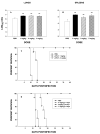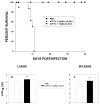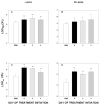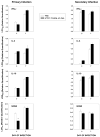Tumor necrosis factor-alpha antagonism by the murine tumor necrosis factor-alpha receptor 2-Fc fusion protein exacerbates histoplasmosis in mice
- PMID: 17572011
- PMCID: PMC2212162
- DOI: 10.1089/jir.2007.0178
Tumor necrosis factor-alpha antagonism by the murine tumor necrosis factor-alpha receptor 2-Fc fusion protein exacerbates histoplasmosis in mice
Abstract
Treatment of some inflammatory conditions with tumor necrosis factor-alpha (TNF-alpha) antagonists is efficacious, but such treatments are associated with infections with intracellular pathogens, including Histoplasma capsulatum. We explored protective immunity to H. capsulatum in mice given a fusion protein consisting of TNF-alpha receptor 2 (TNFR2) bound to the Fc portion of mouse IgG1. Intraperitoneal administration of this inhibitor exacerbated primary or secondary pulmonary infection at dosages ranging from 1 to 5 mg/kg. All mice with primary infection given the inhibitor succumbed to infection within 10-21 days of treatment. In secondary histoplasmosis, mice receiving 1, but not 5, mg/kg survived treatment. Fungal burden was increased even if treatment with the inhibitor was initiated after the onset of infection. The inflammatory response of the lungs of mice given the inhibitor did not differ from that of mice given control vehicle. Susceptibility was not associated with major alterations in cytokines known to protect or exacerbate infection. However, expression of nitric oxide synthase 2 (NOS2) was depressed early in primary infection. These results demonstrate that antagonism of endogenous TNF-alpha by this fusion protein modulates susceptibility. Impaired immunity is not a result of altered cytokine responses or changes in the inflammation and may not be demonstrable in other murine strains.
Figures






References
-
- Anderson PJ. Tumor necrosis factor inhibitors: clinical implications of their different immunogenicity profiles. Semin Arthritis Rheum. 2005;34:19–22. - PubMed
-
- Beutler B, Cerami A. The biology of cachectin/TNF—a primary mediator of the host response. Annu Rev Immunol. 1989;7:625–655. - PubMed
-
- Keane J, Gershon S, Wise RP, Mirabile-Levens E, Kasznica J, Schwieterman WD, Siegel JN, Braun MM. Tuberculosis associated with infliximab, a tumor necrosis factor-α-neutralizing agent. N Engl J Med. 2001;345:1098–1104. - PubMed
-
- Lee JH, Slifman NR, Gershon SK, Edwards ET, Schwieterman WD, Siegel JN, Wise RP, Brown SL, Udall JN, Jr, Braun MM. Life-threatening histoplasmosis complicating immunotherapy with tumor necrosis factor α antagonists infliximab and etanercept. Arthritis Rheum. 2002;46:2565–2570. - PubMed
-
- Wallis RS, Broder MS, Wong JY, Hanson ME, Beenhouwer DO. Granulomatous infectious diseases associated with tumor necrosis factor antagonists. Clin Infect Dis. 2004;38:1261–1265. - PubMed
Publication types
MeSH terms
Substances
Grants and funding
LinkOut - more resources
Full Text Sources
Medical

